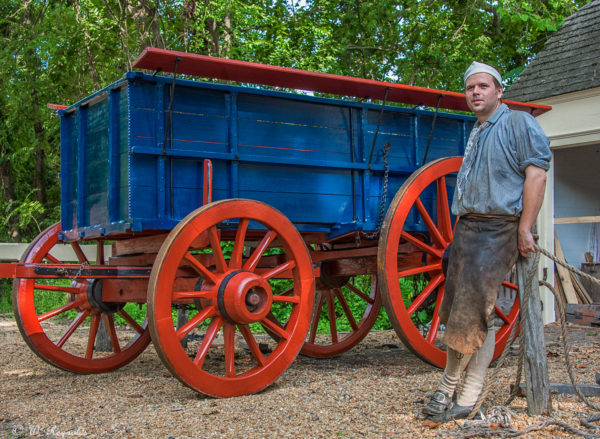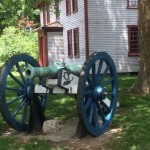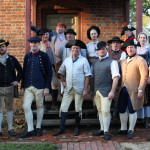
Last week a brand-spanking new wagon made its maiden trip down Duke of Gloucester Street, pulled by Duke and Diamond, a yoke of short-horned steers who recently arrived from Georgia. Within a couple of weeks, the wagon will be pressed into daily service for guests to get a unique ride around Palace Green.
Of course, carriages, not wagons, were a more standard mode of transportation in colonial Virginia. Wagons were used for ferrying cargo, so yes, riders will be playing the role of freight more than that of royal governor. But it will be an especially kid-friendly spin around town in our largest capacity vehicle, with space for ten passengers.
Darin Durham from our Coach & Livestock Department will be one of the drivers leading the way. Duke and Diamond, the three-year old short-horned, or Durham, steers, will be called oxen once they are four. (Oxen are simply cattle that have been trained to work, explains Darin.)
They’ve been trained to work with a yoke since before they were a year old. The wagon has a weight capacity of about two tons, but Duke and Diamond shouldn’t have any trouble pulling it with ease.
The construction of the wagon was a collaborative effort among several historic trades. The design, assembly, and most of the construction was done by our Wheelwright shop, but they had help. The Blacksmiths at the Public Armoury manufactured the iron hardware, including angled supports holding the sideboard and the chains securing the folding tailgate with steps in back.
The Joiners made the four cargo crates that serve as seats for riders. The shop’s new apprentices—Scott, Peter, and Amanda—did most of the work as part of their training. The project, which covered fundamental skills like using a saw, planing materials to dimension, and using hand screws (clamps), the brace and bit for boring pilot holes, was valuable experience from which they’ll progress to more complicated joinery work.
The Military Artificers made leather sleeves for the chains on the tailgate that will help passengers to hoist themselves into the wagon.
And like so many projects, construction of the wagon was made possible by the generosity of a lifelong friend of Colonial Williamsburg from the greater Philadelphia area. Her parents taught her the importance of giving back, and her sons taught her to appreciate the unbridled joy of a ride down Duke of Gloucester Street.
Journeyman Wheelwright Andrew De Lisle drew up the design, a straight-bodied wagon based on similar English styles that would have been familiar in Williamsburg. It had to be a reasonably authentic reproduction of what would have been common in Tidewater Virginia, and a vehicle that would accommodate ten passengers at a time.
Period references were not particularly complimentary of their quality. “The province has no good draught and work-horses and their teams, in the low-country at least, are in general extremely sorry,” Johann David Schopf, a visitor to Virginia in the 1780s, wrote: “One sees everywhere little thin animals, hitched to wagons made of wood throughout, not the smallest bit of iron to be found in the construction.”
Wagons on the colonial frontier of western Virginia were a bit different in construction, which is attributable to the different cultural mix as well as the need to build hardier vehicles that could handle more challenging terrain. The western Virginia wagons were light but strong—equipped for long-distance hauling, and typically having bent wood and iron framing.
Like all their projects, it started with a scale drawing. Most 18th-century wagons were about 10-12 feet long. This one measures about eleven feet long by four feet wide.
The Wheelwrights were able to use a set of standard axles already on hand in the shop. The wheel height was determined by what made the work easiest for the oxen, at least the five-foot high back wheels. The front wheels are a foot shorter to make the wagon easier to turn.
Our Wheelwrights just finished live-streaming the process known as "hooping" a wheel. It was a team effort as they had a little help from our Blacksmiths and our Joiners. (Watch closely! They ran into a little hiccup in the beginning and Andy will explain what happened!). This is the final wheel for the ox wagon that Coach & Livestock is hoping to have up and running by the weekend.It's not too late to ask questions. Leave them in the comments and our Wheelwrights will get back to you!
Posted by Colonial Williamsburg on Monday, June 27, 2016
We recently caught the process of “tiring” one of the wheels for the wagon on video. It offers a fascinating look at the work of the wheelwrights.
The undercarriage, including the wheels, axles, and everything that connects them, was built first. It was set aside after being painted.
Andrew copied the latch design from original wagons in our collections and based the tailgate’s hinges were based on examples at St. Fagans National History Museum in Wales. He had the opportunity to study the craftsmanship of British wheelwrights on a couple of trips across the pond, including last fall’s venture, when he was inducted into the Worshipful Company of Wheelwrights in London.
Next, the Wheelwrights framed, paneled, and painted the body. Apprentice Wheelwrights Victoria and Aaron did much of the initial roughing out of all the timbers, and paneled the body. This was the first time the shop constructed a “waisted” wagon, one with a slightly smaller front end to facilitate turning. Andrew says that it was an enjoyable variation from the usual process, if not especially challenging. The waist is not really visible, as it is framed into the sides.
Al Mitchell, a dedicated volunteer in the Wheelwright Shop (pictured above), mixed all the paint and varnish. He ground the pigments into linseed oil, then thinned it with more oil. The wheels and interior are Venetian red, made from a clay mined in Italy that was a popular color in the 18th century, and easily acquired in Williamsburg.
The color of the body, which has been informally dubbed “ox wagon blue” by the Wheelwright Shop, was the product of several experimental batches. It’s a variation of Prussian blue, the first synthetic pigment. The difference is in the addition of lampblack (made from soot) and some white, for which Al used titanium, rather than the considerably more hazardous lead that would have been used two centuries ago. There are four coats of paint and one coat of varnish.
Altogether, the wagon took about five months to build, a pretty quick pace, especially while undertaking other projects and attending to our guests (who always come first).
Along with the use of 18th-century construction methods, the vehicle was constructed with locally sourced traditional materials. Andrew explained that the vehicle is actually pretty light, at least given how rugged it looks. The bed timbers are oak, the paneling is poplar, and the upright posts and rails frame is ash. The wheels have the usual elm hubs and oak spokes.
With the exception of the tailgate, which was included to accommodate riders, this is the first truly eastern Virginia 18th-century-style freight wagon to go onto the streets here.
New Working Steers & New Wagon: Let's Take 'Em For a Spin!
Posted by Colonial Williamsburg on Thursday, July 7, 2016
The video above captures Duke and Diamond hauling the wagon on its inaugural journey.
You’ll see the wagon carrying loads around town, and rides will be offered beginning in late July, operating daily between 10 a.m. and 1 p.m., weather-permitting. A 15-minute ride around Palace Green costs $5 per passenger. Make your reservations at any on-site ticket selling location.
Special thanks to Wayne Reynolds and Fred Blystone for the pictures for this post!


What a beautiful wagon! My great grandfather was a blacksmith and wagon maker from 1860 - early 1900’s so I find the process especially interesting. Would there ever be an opportunity at CW for multiple yoke of oxen to be hitched to wagon to pull at the same time? Also, would it be difficult to hitch up and work a pair of oxen who are normally each partnered with another ox or is this just not able to be done without extra training and breaking in period?
Sorry for the delayed response, Mary Anne. I reached out to Cameron Green from our Coach & Livestock Team and here is his response: “That is a great story about your great grandfather. Thanks for sharing. We will be working a team of oxen (two yokes of oxen) at Colonial Williamsburg as much as we can. It is a really interesting thing for people to see, as well as for us to do. We have done some work with a team in the past, and are hoping to do it more and more often. As for working oxen with other oxen that they do not usually get yoked with…it is possible. However, it does take some adjusting. A few years back it was done for a little while at Colonial Williamsburg. Thanks for your inquiry! “
Jack Lynn says
When my son was 2 (he is now 42) we visited CW and they had an Ox Cart ride. I think the cost was the same. ($5.00) My son went on the ride that was supposed to last 15 minutes around Market Square. They had no other reservations that day so the ox-cart driver James and my son James came back to the Compton Oak about 1 Hour later. James had the time of his life on that ride.
That’s a great story, Jack. Thank you for sharing!
How can I obtain access to the livestreaming feeds as they occur?
Helene - we usually promote them on Facebook a couple of hours before they occur. Sometimes, we’re able to promote them the night before. From there, you just have to go to our Facebook page at the start time. We have heard that there will soon be a new feature where you can register for these and get alerts before they begin. Because our museum is an official, verified page, this feature would roll out to us first so we’ll definitely keep you posted!
Jessica, that’s great but there are many who are not on Facebook. What then? Any access to live streaming?
It’s a beuatiful example of craftsmenship. WOW.
Thanks for posting this. CW really is alive with all of the tradespeople now employed and visible to the public.
Another fine product from the Historic Trades shops. Good work, all.
[a Wheelwright Shop alum]